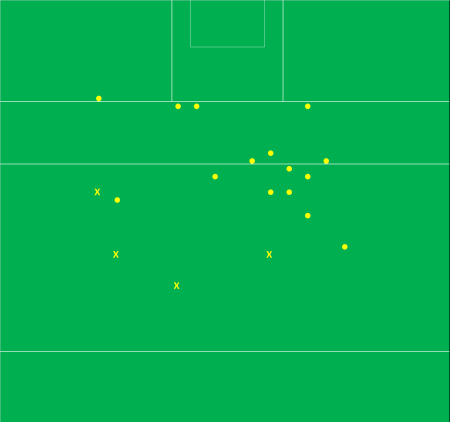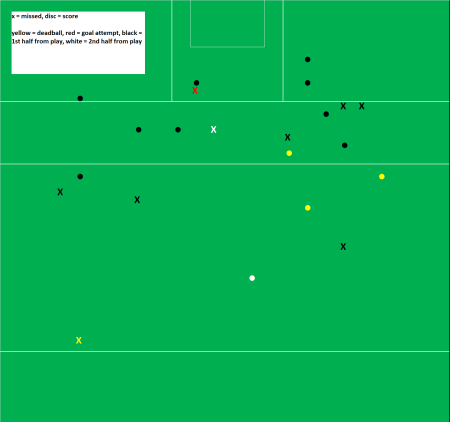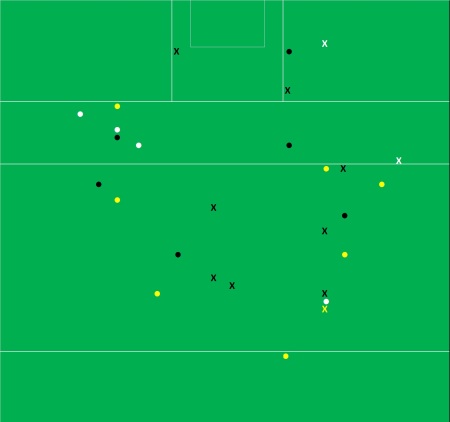Comparing league and Championship
I have only ever used Championship games when creating specific averages or metrics. In the main this was due to laziness on my part as I wasn’t really tracking League games but there was also a part of me that viewed League & Championship as sufficiently different to be treated individually. Separate entities. Different games on different pitches in different weather.
But then I got notions and tracked the 2018 league. Was the league data sufficiently similar to that of recent Championships allowing us to augment existing datasets and produce more robust outcomes? Or did the “gut feeling” that the two should be kept separate stand up to even the most rudimentary of reviews?
In the end 22 League, and 32 Championship, games were tagged (a fancy way of saying “noted a lot of different things within a game”) throughout the year. A nice, healthy, robust possession count of just under 5,000.
Given the size of the dataset, and the fact that the games reviewed were within the same calendar year, any differences should really be due to the competition, and its peculiarities, rather than any observed changes in styles throughout the years. (And as a nice aside we’ll also have a clean, comparable, dataset to test the effects, if there are any, of the new rules being introduced in 2019).
Game flow
At the outset it became obvious, despite the best intentions of curtailing the review to one season, that we were not comparing apples with apples. Within the 32 Championship games there were quite a few where the disparity between the two teams’ quality was very evident (somewhat expanded upon here). So the 2018 Championship returns were subdivided further into (a) all Championship games and (b) those games between Division1 teams only (Dublin, Tyrone, Galway, Monaghan, Donegal, Kerry, Kildare & Mayo) of which we had a healthy number – 15 in total – thanks to the introduction of the Super8s.
And we have our first surprise. There were as many possessions per game in the league as there were in the Championship; and the differences between the two Championship subdivisions were small enough to be deemed immaterial. I say “surprise” as, based on nothing more than intuition, I fully expected there to be more possessions during the League as a result of increased turnovers through weather, heavy pitches and teams not being quite at their peak.
Now there were more turnovers during the league – five a game – but this was counter balanced by how teams used the ball. There is an appreciable step up in attacking production across the Championship with higher Attack and Shot Rates. Both these then lead to noticeably more shots (~8.5%) per game. More shots equal more kickouts.
Those turnover possessions “lost” from the League to the Championship were regained through extra kickouts resulting in the immaterial movement in the total number of possessions.
Kickouts
Viewing kickouts in isolation that point is further evidenced; kickouts account for 49% of all possessions in the League but 54% in the Championship.
Teams were much more on point on kickouts throughout the Championship retaining possession at a much higher rate than they did during the League (77% v 70%).Teams won more short ones (95% v 91% during the league) as well as more of the longer ones (61% v 56% during the league).
One of the contributing factors here could be the well-worn training cycle within GAA where teams work on kickout routines coming into the Championship as the winter months are used to lay down a fitness block.
Interestingly this is the first time we see a break in how the two Championship subdivisions perform. During the league the kickout team won 56% of their own kickouts that went past the 45; this stepped up to 61% in the Championship and again to 66% when we segment just the Div1 teams.
A jump in retention rates from 56% to 65% on kickouts past the 45 is quite noticeable – especially on those kickouts that should be the most contestable. The teams, and the quality of the opponent, haven’t changed. Instead teams have just improved.
This stepped increase in retention rates, both from league to Championship and within the Championship subdivisions, lends credence to the above supposition that teams “work on” their kickouts more in the lead up to Championship than they do in the League with the better teams, i.e. Div1, being more successful at implementing their plans.
Shooting
As noted above there are more shots attempted during the Championship. But that alone does not account for the higher scoring rates observed during the summer. Teams are more efficient with that extra shooting. And not just in one particular phase but across all three – point attempts, both from play and deadballs, as well as goal attempts.
Point attempt Conversion Rates (from play) during the League were lower than those in the Championship. But not massively so. They are probably within any margin of error so further work is required to confirm if this a League v Championship, early season v late season, bad weather and heavy pitches v good weather and “proper” pitches thing or just one season noise.
Deadball returns have improved the last two Championships (2018 – 74.0%, 2017 – 73.5%, 2016 – 69.0%, 2015 – 68.9%) so the 72.2% achieved within the 2018 League feels like a lag. Again though it is within any margin of error so it is probably wise to err on the side of caution and say that the differences are inconclusive.
Goal shots are probably the most eye catching numbers with just 32% of shots converted during the League and 39% during the Championship. Again those Championship games involving the Div1 teams saw another slight bump to 41%. The volume of goal attempts in those Championship games was less at 4.2 per game (as against 4.7 during the league) yet they were converted at a much higher rate. Why? More work done on finishing moves? Random one year fluctuations on small sample sizes? Effect of must win games in the Championship ensuring players take points off less clear cut chances? That most unsatisfactory of answers … to be determined.
Instinctively the Conversion Rates for all three elements, deadballs, point attempts and goal attempts, being lower in the League feels right. As stated I have never been a fan of mixing data from the two competitions and whilst the disparities are probably small enough for some the differences just reinforce my original belief that, without further analysis, we shouldn’t just lump the two competitions together to get bigger volumes.
So there you have it. At a macro level League games are similar to Championship games with the same number of possessions and comparable Conversion Rates. But get under the hood and the makeup of each component differs just enough to warrant (for me anyway) keeping all metrics for the two separate.
One final quick note
Defence
Unfortunately there are no great defensive metrics per se. The sign of a good defensive performance is usually evidenced by the absence of good offensive metrics for the opposition. But that doesn’t really work here when we are looking at averages in the round as everything just becomes an aggregate blob with no real decipherable differences.
Some specific defensive metrics we can look at are turnover rates (though the assumption that all turnovers are induced by the defence doesn’t hold much water), how often teams get in for an attempt at goal and the pressure faced by teams when shooting.
Focussing on the Div1 teams we can see a tightening up on the defensive front with a ~10% increase, from the league to the Championship, in the number of shots taken under strong pressure. There is also a ~10% increase in the number of possessions it takes to get a shot on goal.
As well as getting more clinical on their use of possessions and kickouts the Div1 teams also tightened up defensively (balanced by more efficient shooting). Everything trends towards the Championship just being that step ahead of the League. Sometimes what you see really is what you get.











































